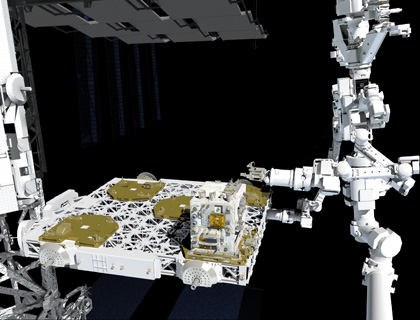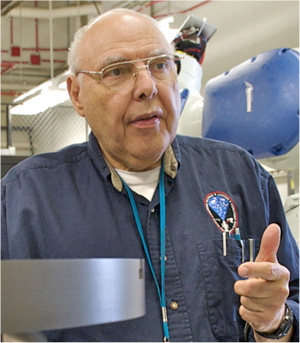Concluding Shuttle Mission Launches Robotic Possibilities
July 7, 2011 - When Atlantis rises above launch pad 39A to begin her final voyage, the transport truck will also carry the distinction of hauling the most supplies and science components, by weight, of any other shuttle. Stowed in the aft end will be a Goddard payload designed to begin demonstrations into the possibilities of future robotic satellite servicing.

RRM uses the International Space Station's "Dextre" robot (right) to test whether a robot could refuel a satellite in space. (Artist's Concept)
The Robotic Refueling Mission (RRM) is a module, to be placed externally onto the International Space Station (ISS) designed to demonstrate technologies, techniques and test tools needed to robotically refuel satellites currently orbiting the Earth. This joint effort with the Canadian Space Agency (CSA) will be the first on-orbit attempt to test how to refuel a spacecraft not built with on-orbit servicing in mind.
Shared results of this two-year technology test bed are expected to reduce risks and lay the foundation and encourage future robotic servicing missions. Those future missions could also include repair and repositioning of orbiting satellites.
"You know NASA has been doing space servicing for quite some time now," said Frank Cepollina, Associate Director of the Satellite Servicing Projects Division (SSPD) at Goddard. "We will be demonstrating abilities that will allow for the servicing of existing satellites and could influence the build of future satellites to allow easy on-orbit access for refueling and repair."
Satellite servicing, with astronauts, is not new for NASA. Skylab, NASA's first space station, was repaired in space in 1973. Solar Maximum and Syncon IV, with help from the shuttle, were successfully repaired in the 1980's. In the 1990's NASA serviced the Compton Gamma Ray Observatory, Intelsat 6 and began a series of highly successful servicing missions to the Hubble Space Telescope (HST).

Cepollina, Associate Director, believes it is just a matter of time before robotic servicing could become routine.
More recently human and robotic servicing capabilities have contributed to the assembly, upkeep and repair of the ISS. With RRM, NASA can begin the work of confirming the robotic satellite-servicing technologies needed for the development of future robotic servicing spacecraft.
Cepollina believes it is just a matter of time before such servicing could become routine. "If we are to venture further from Earth the need for robotic servicing will increase," said Cepollina. "With the build of the space station we see the increase of collaboration between human and robotic abilities in space servicing."
On day five of the shuttle mission, space station astronauts will remove RRM from the shuttle's cargo bay and place the module onto a temporary position. Soon after the shuttle's departure using Canadarm2, RRM will be permanently secured on ExPRESS Logistics Carrier 4 (ELC-4) also built at Goddard. The ELC provides command, telemetry and power support for the module.
The RRM module is about the size of a washing machine and weighs approximately 550 pounds, with dimensions of 43" by 33" by 45". RRM includes 0.45 gallon (1.7 liters) of ethanol that will be used to demonstrate fluid transfer on orbit.
RRM operations will be entirely remote controlled by flight controllers at Goddard, Johnson Space Center, Marshall Space Flight Center, and the CSA's control center in St. Hubert, Quebec. The station's two-armed robotic system, Special Purpose Dexterous Manipulator, or Dextre, will manipulate the tools necessary for the demonstrations. RRM will be the first use of Dextre beyond the planned maintenance of the space station for technology research and development.
Onboard the RRM module will be four unique tools developed at Goddard: the Wire Cutter and Blanket Manipulation Tool, the Multifunction Tool, the Safety Cap Removal Tool, and the Nozzle Tool. Each tool will be stowed in its own storage bay until Dextre retrieves it for use. To give mission controllers the ability to see and control the tools, each tool contains two integral cameras with built-in LEDs.
"Robotic refueling and satellite servicing could extend the lifetimes of satellites offering significant savings in delayed replacement costs," said Cepollina. "Such servicing has the potential to allow human and robotic explorers to reach distant destinations more efficiently and effectively."
Drawing upon 20 years of experience servicing the HST, the SSPD initiated the development of RRM in 2009. Atlantis, the same shuttle that carried tools and instruments for the final, astronaut-based HST Servicing Mission 4, will now carry the first step to robotic refueling and satellite servicing on the last shuttle mission to space.
Dewayne Washington
Office of Communications
NASA's Goddard Space Flight Center

 RRM uses the International Space Station's "Dextre" robot (right) to test whether a robot could refuel a satellite in space. (Artist's Concept)
RRM uses the International Space Station's "Dextre" robot (right) to test whether a robot could refuel a satellite in space. (Artist's Concept) Cepollina, Associate Director, believes it is just a matter of time before robotic servicing could become routine.
Cepollina, Associate Director, believes it is just a matter of time before robotic servicing could become routine.

